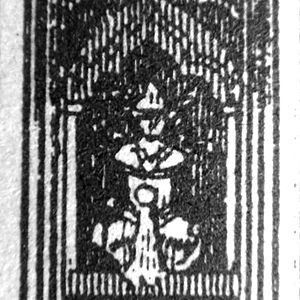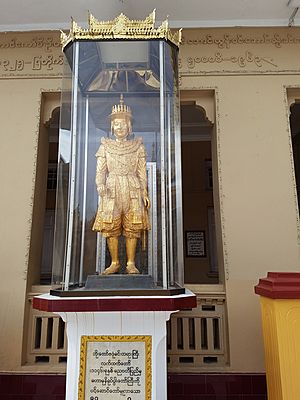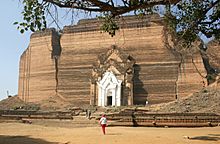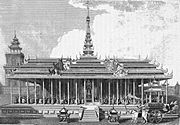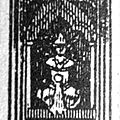Bodawpaya facts for kids
Quick facts for kids Bodawpayaဘိုးတော်ဘုရား |
|||||
|---|---|---|---|---|---|

Statute of Bodawpaya at Mandalay Palace
|
|||||
| King of Burma Prince of Badon |
|||||
| Reign | 11 February 1782 – 5 June 1819 | ||||
| Predecessor | Phaungka | ||||
| Successor | Bagyidaw | ||||
| Born | Maung Waing မောင်ဝိုင်း 11 March 1745 Moksobo |
||||
| Died | 5 June 1819 (aged 74) Amarapura |
||||
| Burial | Amarapura | ||||
| Consort | Min Lun Me 207 queens in total |
||||
| Issue | 62 sons, 58 daughters including: Thado Minsaw | ||||
|
|||||
| House | Konbaung | ||||
| Father | Alaungpaya | ||||
| Mother | Yun San | ||||
| Religion | Theravada Buddhism | ||||
Bodawpaya (Burmese: ဘိုးတော်ဘုရား, pronounced: [bódɔ̀ pʰəjá]; Thai: ปดุง; 11 March 1745 – 5 June 1819) was the sixth king of the Konbaung dynasty of Burma. This dynasty was a powerful royal family that ruled Burma for many years. Bodawpaya was born as Maung Shwe Waing. He was the fourth son of Alaungpaya, who founded the Konbaung dynasty and the Third Burmese Empire.
Bodawpaya became king after removing his nephew, Phaungkaza Maung Maung, from power in Ava. In 1782, King Bodawpaya moved the capital city back to Amarapura. He was also known as Hsinbyumyashin, which means "Lord of the White Elephants." This name was given to him because white elephants were seen as very special and lucky. Later, people called him Bodawpaya, meaning "Grandsire," because his grandson, Bagyidaw, became king after him. Bodawpaya had many children, including 70 sons and 67 daughters.
Contents
Military Expeditions and Conflicts
Bodawpaya was also known as Bodaw U Waing. He led his armies to invade Arakan in 1784. His son, Thado Minsaw, led the royal armies across the Western Yoma mountains. The capital of Arakan, Mrauk U, was captured at the end of 1784.
Many valuable items were taken back to mainland Burma. These included the famous Mahamuni Buddha image and bronze statues from Khmer. You can still see these treasures in Mandalay today. About 20,000 people were also taken as captives and became servants for pagodas and temples. Once Arakan became part of Burma, its borders touched British India.
In 1794, the people of Arakan rebelled. The British Governor of India, Sir John Shore, sent Captain Michael Symes on a special trip. Symes's mission was to gather information about Burma, which was still known as the Kingdom of Ava to the outside world.
Wars with Siam
Bodawpaya invaded Siam in 1785, but his army was defeated. In 1791, the Governor of Tavoy rebelled with help from the Siamese. Bodawpaya sent a strong force by sea to stop the rebellion. After some fighting, peace talks happened in 1793. As a result, the Tenasserim coast became part of Burma.
He invaded Siam again in 1809, but he was stopped by Maha Senanurak. This loss meant that Burma's control over the Lan Na region ended after 200 years.
Invasions of Assam
In 1816, a governor from Assam, named Badan Chandra Borphukan, visited Bodawpaya's court. He asked for help to defeat his rival, Purnananda Burhagohain. Bodawpaya sent a large army of 16,000 soldiers to Assam. The Burmese army entered Assam in January 1817 and won a battle.
After this, the king of Ahom, Chandrakanta Singha, made peace with Badan Chandra Borphukan and the Burmese. The king made Badan Chandra Borphukan his Prime Minister. An Ahom princess was also given in marriage to King Bodawpaya, along with many gifts. The Burmese army then left Assam.
A year later, Badan Chandra Borphukan was killed. King Chandrakanta Singha was removed from power by a rival group. Chandrakanta Singha and his friends asked Bodawpaya for help again. In February 1819, the Burmese forces invaded Assam a second time. They put Chandrakanta Singha back on the throne of Assam.
Religion and Culture
Bodawpaya believed he was the next Buddha or Maitreya. However, the group of senior monks, called the Sangha, did not agree with his claim. During his time as king, learning and education became very important. This was because he created a group of senior monks, called Sangharajas. Their job was to make sure the Sangha remained pure and followed Buddhist rules strictly.
Bodawpaya also helped settle a disagreement about how monks should wear their robes. He decided that monks should cover both shoulders when collecting alms. This helped unite the Order of Monks under the Thudhamma order. Burma became a protector of Buddhism in the region. The special ordination ceremony, called upasampada, was even brought back to Sri Lanka. There, it helped create a new group of monks called the Amarapura Nikaya.
In 1790, Bodawpaya started building a huge stupa called Mantalagyi (Great Royal Stupa) at Mingun. This site is about 11 kilometers up the Irrawaddy River from Mandalay. However, the stupa was never finished. A prophecy spread that said, "Once the great pagoda has been wrought, the Moksoe dynasty will come to nought." This meant that if the pagoda was finished, the king's family would lose power.
The stupa was planned to be 150 meters tall, so tall it could be seen from Shwebo, the birthplace of the dynasty. An earthquake in 1838 caused large cracks in the building. It also made the heads of two giant lion-like statues, called chinthes, fall into the river.
There was also a huge 90-ton bell made for the stupa, called the Mingun Bell. It was cast between 1808 and 1810. For a while, it was the largest ringing bell in the world.
Bodawpaya also supported the performing arts. He appointed a special minister for entertainment, called Thabin Wun. He also made strict rules for performances. In 1784, he ordered a major study of the kingdom's economy.
Bodawpaya died in 1819. His grandson, the Prince of Sagaing, became the next king and was known as Bagyidaw. Bagyidaw's father, who was the heir to the throne, had passed away in 1808.
Images for kids
See also
 In Spanish: Bodawpaya para niños
In Spanish: Bodawpaya para niños


